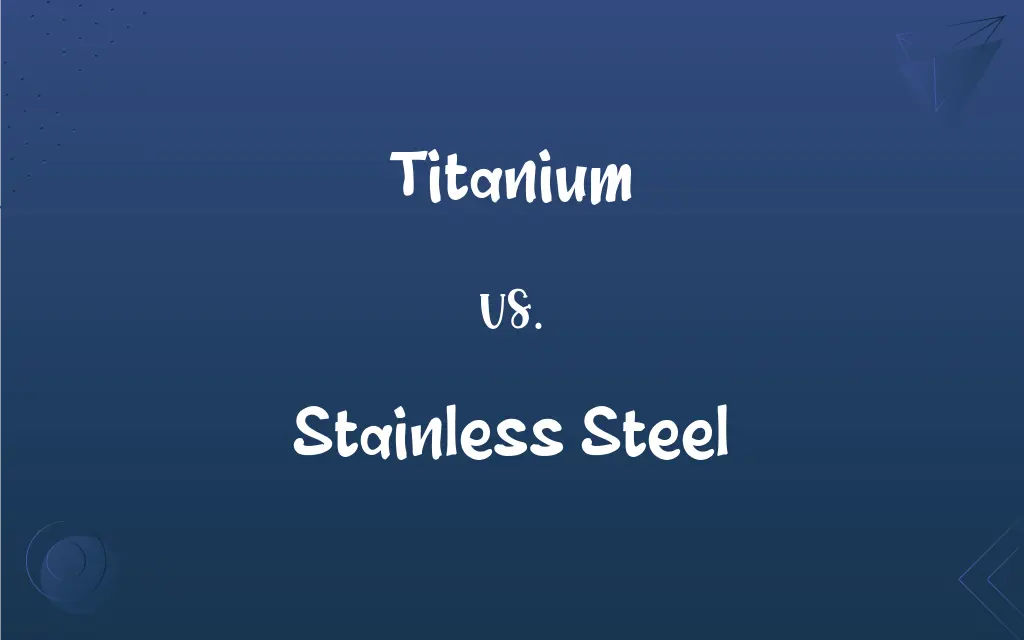Titanium vs. Stainless Steel: What's the Difference?
Edited by Harlon Moss || By Janet White || Updated on October 18, 2023
Titanium is a strong, lightweight, corrosion-resistant metal, while stainless steel is an iron-carbon alloy with chromium, known for durability and rust resistance.

Key Differences
Titanium is a high specific strength metal whereas stainless steel is a mixture of different metals.
Titanium is metal while stainless steel is an alloy.
Titanium is denser on the flip side stainless steel is less dense.
Titanium is costly to purchase on the other hand; stainless steel is available at suitable prices.
Titanium has low specific gravity conversely stainless steel has higher.
ADVERTISEMENT
Titanium is biocompatible while stainless steel is not biocompatible.
Titanium has its natural properties while properties of stainless steel are made by mixing metals.
Titanium uses are in aircrafts industries, whereas stainless steel uses are in healthcare products.
Titanium is renowned for its high strength-to-weight ratio and natural resistance to corrosion, even from salt water. Conversely, Stainless Steel is an alloy combining iron, chromium, and other metals, making it highly resistant to corrosion, staining, and rusting.
Titanium possesses a high melting point, making it ideal for applications that require resistance to extreme temperatures. Stainless Steel, while also having a high melting point, is used in scenarios where strength and resistance to wear are more critical.
ADVERTISEMENT
Biocompatibility is a notable feature of Titanium, making it an excellent material for medical implants. In contrast, Stainless Steel is used for surgical instruments, given its resistance to sterilization processes.
In the jewelry industry, Titanium is appreciated for its hypoallergenic properties and durability, whereas Stainless Steel is valued for its luster, appearance, and affordability.
While Titanium is abundant in nature, its extraction and refinement processes are more complex and expensive. Stainless Steel is more easily produced, making it more affordable and widely utilized in various industries.
Comparison Chart
.
Titanium is a highly corrosive resistant metal.
Stainless steel is an alloy of different metals.
Element
Metal
Alloy
Density
Denser
Less dense
Price
Expensive
Suitable price
Weight
Low
High
Characteristics
Natural
Created by mixing of metals
Biocompatibility
Yes
No
Uses
In the aerospace industry, jewelry
Kitchenwares, healthcare products
Composition
Element
Alloy
Corrosion
Highly resistant
Resistant with chromium
Cost
Generally more expensive
More affordable
Industry usage
Aerospace, medical fields
Construction, culinary, medical tools
Titanium and Stainless Steel Definitions
Titanium
Resistant to corrosion in sea water, aqua regia, and chlorine.
Titanium is often used in naval ships, spacecraft, and missiles because of its resistance to corrosion.
Stainless Steel
Known for its ease in fabrication and cleaning.
Hospitals rely on Stainless Steel instruments for their ease of sterilization.
Titanium
Has the highest strength-to-density ratio of any metallic element.
In sports, Titanium is used to manufacture lightweight bicycles and golf clubs.
Stainless Steel
Notable for its corrosion resistance and durability.
Stainless Steel is often selected for building exteriors due to its ability to withstand harsh weather conditions.
Titanium
Occurs in numerous minerals, primarily rutile and ilmenite.
Titanium is extracted from minerals like rutile, found in beach sands in Australia.
Stainless Steel
An alloy of iron and chromium, resistant to tarnishing and rust.
Stainless Steel is commonly used in kitchen appliances and cookware.
Titanium
Used extensively for medical implants due to its biocompatibility.
Due to its non-toxic and non-allergenic properties, Titanium is used for surgical implants.
Stainless Steel
Often categorized into grades based on its alloy composition and characteristics.
Food grade Stainless Steel is used in the creation of kitchen utensils and cutlery.
Titanium
A lustrous transition metal with a silver color, low density, and high strength.
The aerospace industry frequently uses Titanium for its high strength-to-weight ratio.
Stainless Steel
Recyclable, with approximately 60% of new stainless steel coming from melted scrap metal.
Stainless Steel remains valuable in scrap yards due to its recyclability.
Titanium
A strong, low-density, highly corrosion-resistant, lustrous white metallic element that occurs widely in igneous rocks and is used to alloy aircraft metals for low weight, strength, and high-temperature stability. Atomic number 22; atomic weight 47.87; melting point 1,668°C; boiling point 3,287°C; specific gravity 4.51; valence 2, 3, 4. See Periodic Table.
Titanium
A chemical element, atomic number 22; it is a strong, corrosion-resistant transition metal, used to make light alloys for aircraft etc.
Titanium
(countable) A single atom of this element.
Titanium
An elementary substance found combined in the minerals manaccanite, rutile, sphene, etc., and isolated as an infusible iron-gray amorphous powder, having a metallic luster. It burns when heated in the air. Symbol Ti. Atomic weight 48.1.
Titanium
A light strong gray lustrous corrosion-resistant metallic element used in strong light-weight alloys (as for airplane parts); the main sources are rutile and ilmenite
FAQs
How is Stainless Steel made?
Stainless Steel is made by combining iron with at least 10.5% chromium and other elements like nickel and molybdenum for enhanced properties.
Is Stainless Steel rust-proof?
Stainless Steel is highly resistant to rust due to its chromium content, which forms an invisible protective layer.
How does Stainless Steel prevent corrosion?
The chromium in Stainless Steel reacts with oxygen to form a thin, invisible layer of chrome-containing oxide, protecting the surface.
Can Titanium be used in jewelry?
Yes, Titanium is hypoallergenic and durable, making it an excellent material for jewelry.
What industries use Titanium?
Key industries include aerospace, medical, automotive, and sporting goods.
What is Titanium?
Titanium is a strong, lightweight, and corrosion-resistant metallic element.
Why is Titanium used in airplanes?
Titanium's high strength-to-weight ratio and resistance to temperature extremes make it ideal for aerospace applications.
Is Titanium stronger than steel?
Titanium has a higher strength-to-weight ratio, but steel can have higher overall strength.
What are the main uses of Stainless Steel?
Stainless Steel is widely used in kitchenware, construction, and medical equipment due to its durability, ease of maintenance, and corrosion resistance.
Why is Titanium considered biocompatible?
Titanium is non-toxic and isn't rejected by the body, making it perfect for medical implants.
Why is Stainless Steel used in kitchens?
Its resistance to corrosion, ease of cleaning, and aesthetic appeal make Stainless Steel ideal for kitchens.
Does Stainless Steel contain iron?
Yes, Stainless Steel is primarily composed of iron, combined with chromium and other metals.
How is Stainless Steel recycled?
Stainless Steel is recycled by melting scrap metal to create new products, preserving resources.
How is Titanium sourced?
Titanium is sourced from minerals like rutile and ilmenite, extracted from the Earth’s crust.
Is Stainless Steel magnetic?
Some types of Stainless Steel are magnetic, while others are not; it depends on the alloy's composition.
Can Stainless Steel be used in surgery?
Yes, it's used for surgical instruments due to its resistance to corrosion and ease of sterilization.
Is Stainless Steel safe for food storage?
Yes, food-grade Stainless Steel is safe as it doesn’t leach chemicals and resists bacteria.
Is Titanium a rare metal?
Though widely distributed in the Earth’s crust, Titanium is not abundantly available and requires complex processing.
What colors does Titanium come in?
Titanium is naturally silver but can be anodized to produce various colors.
Can Titanium rust or corrode?
Titanium is extremely resistant to rust and corrosion, even in harsh environments.
About Author
Written by
Janet WhiteJanet White has been an esteemed writer and blogger for Difference Wiki. Holding a Master's degree in Science and Medical Journalism from the prestigious Boston University, she has consistently demonstrated her expertise and passion for her field. When she's not immersed in her work, Janet relishes her time exercising, delving into a good book, and cherishing moments with friends and family.
Edited by
Harlon MossHarlon is a seasoned quality moderator and accomplished content writer for Difference Wiki. An alumnus of the prestigious University of California, he earned his degree in Computer Science. Leveraging his academic background, Harlon brings a meticulous and informed perspective to his work, ensuring content accuracy and excellence.































































